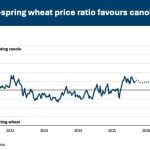Prairie residents may have noticed something missing in the sky this winter, which could be good and bad for farmers.
The past two winters have been an exceptionally quiet period for the aurora borealis, which is normally visible across the Prairies several times in a year.
The lack of lights can be explained by lack of activity in the sun’s magnetic field, says Doug Biesecker, an astronomer with the U.S. National Oceanic and Atmospheric Administration’s (NOAA) Space Weather Prediction Center.
Read Also

Farmers urged to be grain-safe this fall
Working around grain bins comes with risk, from farmers falling to drowning in grain: Experts have five tips to help avoid grain-related accidents this harvest.
Scientists such as Biesecker count the number of sunspots to measure the intensity of activity in the sun’s magnetic field.
However, there hasn’t been much to monitor during the last couple of years because the number of observed sunspots per month has been close to an all-time low.
“The last time it was this low was 1913,” said Biesecker.
The average number of observed sunspots was four or less per day for almost all of 2008 and most of 2009, based on NOAA data. At the peak of solar activity, the number of sunspots is more like 120 per day.
The lack of sunspots is good news for farmers who practice precision agriculture because storms in the sun’s magnetic field can disrupt GPS equipment.
However, it’s not great news for the weather because some forecasters believe fewer sunspots mean cooler temperatures on Earth.
The theory of a correlation between sunspots and weather is based on a period in the sunspot record called the Maunder Minimum, said Francis LeBlanc, an astrophysicist at the University of Moncton.
The sunspot cycle typically lasts 22 years, with a peak of activity at 11 years and the minimal amount of sunspots 11 years later. However, scientific records show that few sunspots appeared from 1645 to 1715, which overlaps a period when Europe experienced unusually cold weather.
“The period from 1300 to 1715 is known as the little ice age in Europe,” said LeBlanc, which led to the modern conclusion that sunspots and terrestrial temperatures are related.
The Old Farmer’s Almanac and other weather prognosticators use the connection to prepare their long-term forecasts, but LeBlanc doesn’t buy the relationship.
The Maunder Minimum was only present during a small portion of the little ice age, he said, which doesn’t explain the other three centuries of cool temperatures. As well, the sun emits the same heat regardless of the number of sunspots.
“If there are more or less sunspots, the sun is almost the same brilliance.”
Biesecker is less skeptical. He believes there is a relationship between the sunspot cycle and ex-tended periods of cooler or warmer temperatures on Earth.
“Are you talking weather or are you talking climate?” he said.
“Does the sun have some connection to climate? Absolutely.”
However, he doesn’t believe that the current period of low sunspot activity means there will be a cool summer this year.
What is noteworthy about this sunspot cycle, Biesecker said, is that it’s emerging slowly from the minimum, which occurred in December 2008. The slow growth in sunspot numbers suggests that the peak of this new cycle will be lower, he added.
That means fewer GPS interruptions and possibly cooler weather over the next decade.















